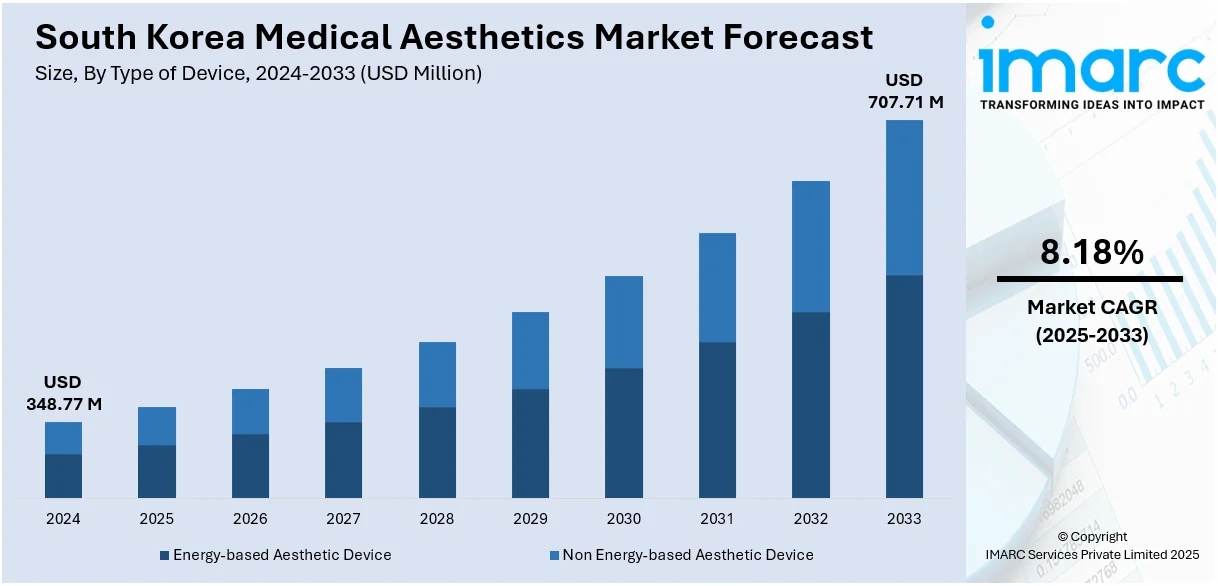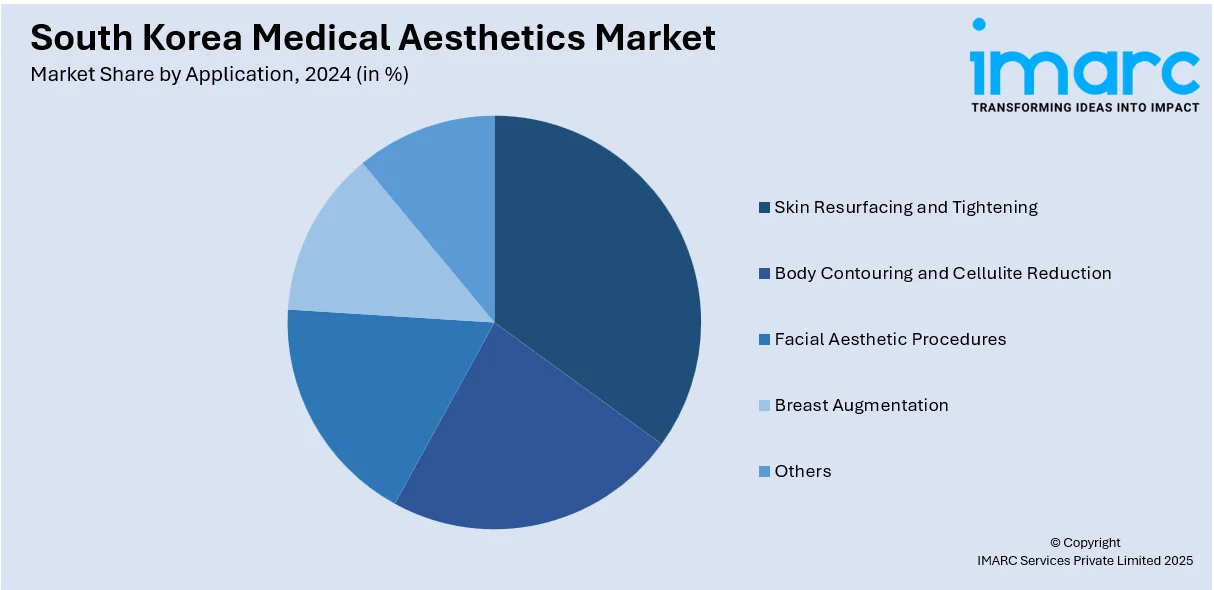
South Korea Medical Aesthetics Market Size, Share, Trends and Forecast by Type of Device, Application, End User, and Region, 2025-2033
South Korea Medical Aesthetics Market Overview:
The South Korea medical aesthetics market size reached USD 348.77 Million in 2024. Looking forward, the market is expected to reach USD 707.71 Million by 2033, exhibiting a growth rate (CAGR) of 8.18% during 2025-2033. The market is powered by high cultural value placed on beauty, broad consumer acceptance of cosmetic procedures, and technological innovation in non-invasive treatments. South Korea's established skincare and beauty sector underpins consumer education and demand for quality aesthetic care. Local innovations in laser technology, injectables, and skincare integration further improve accessibility and treatment results, thereby fueling the South Korea medical aesthetics market share.
|
Report Attribute
|
Key Statistics
|
|---|---|
|
Base Year
|
2024
|
|
Forecast Years
|
2025-2033
|
|
Historical Years
|
2019-2024
|
| Market Size in 2024 | USD 348.77 Million |
| Market Forecast in 2033 | USD 707.71 Million |
| Market Growth Rate 2025-2033 | 8.18% |
South Korea Medical Aesthetics Market Trends:
Culture and Beauty Norms Influencing High Demand for Skin and Facial Treatments
Beauty is culturally significant in South Korea, which has given rise to a vibrant market for medical aesthetic treatments centered on facial and skin rejuvenation. Aesthetic procedures such as skin rejuvenation, non-surgical face lifts, and pigmentation removal are popular, and they track local demand for vibrant, youthful-looking complexions and well-defined facial contours. Korean clients tend to seek out treatments that emphasize subtle rather than radical change, tracking current notions of natural beauty. Facilities in Seoul's Gangnam precinct, Busan, and Daegu specialize in high-tech techniques employing lasers, injectables, and skin rejuvenation treatments adapted to sensitive East Asian skin types. The services are also often packaged with skincare routines and follow-up maintenance schedules to build regular patient relationships. With heightened social media influence and beauty culture trends like K‑beauty, demand for medical aesthetic treatments remains on the rise. Clinics increasingly combine aesthetic medicine with custom skincare regimens and aftercare products to maintain long-term results. The preferred appeal of facial beauty, symmetry, and flawless skin ensures that sophisticated consumer tastes are served by medical aesthetic clinics, establishing South Korea as a world center for cutting-edge cosmetic dermatology.

To get more information on this market, Request Sample
Technology-Driven Innovation and Non-Invasive Procedure Popularity
South Korea's medical aesthetics sector is characterized by technological innovation at a lightning-fast pace, particularly the use of non-invasive or minimally invasive procedures. Procedures like fractional lasers, ultrasound tightening, radiofrequency microneedling, and high precision injectables are most common and continuously upgraded by local clinics and manufacturers. Customers prefer treatments that have minimal downtime, fewer side effects, and instant visible results. Clinics use digital imaging diagnostics and AI-powered skin analysis devices to customize treatments exactly to individual skin type and facial structure. South Korea's robust medical device and skincare technology ecosystem facilitates local innovation, allowing clinics to implement state-of-the-art protocols and partner with local biotech companies. In addition, practice integration of LED phototherapy, platelet-rich plasma therapy, and regenerative injectables is an indication of a tendency toward the integration of medical-grade procedures and wellness-oriented aesthetics. This technology-driven approach promotes high patient confidence and return visits, paving the way for South Korea medical aesthetics market growth.
Medical Tourism and International Patients Powering Premium Service Standards
South Korea's excellence in medical aesthetics has generated substantial inbound medical tourism activity, with patients from throughout Asia and around the globe traveling to Seoul, Jeju Island, and other major centers for procedures. International clinics provide integrated packages that combine consultation, translation facilities, accommodation, and post-treatment care, and high-quality, safe expectations are met. Brands advertise dual use clinics that combine medical beauty and dermatology and plastic surgery for domestic and foreign patients who want premium aesthetic treatment. The fact that there are specialized medical tourism agencies in areas like Gangnam helps ensure that there is a smooth flow of patients and maintains high standards. This international demand motivates clinics to implement multilingual service staff and worldwide compliance guidelines, escalating treatment quality overall. Moreover, international patient feedback compels clinics to compete in having up-to-date technology and licensed medical professionals. In response, aesthetic centers continue to implement new types of procedures and post-treatment procedures, escalating service levels throughout the industry. Export of Korean aesthetic brands and techniques via tourism enhances South Korea's medical aesthetics market's global-leading, patient-centered reputation.
South Korea Medical Aesthetics Market Segmentation:
IMARC Group provides an analysis of the key trends in each segment of the market, along with forecasts at the country and regional levels for 2025-2033. Our report has categorized the market based on type of device, application, and end user.
Type of Device Insights:
- Energy-based Aesthetic Device
- Laser-based Aesthetic Device
- Radiofrequency (RF) Based Aesthetic Device
- Light-based Aesthetic Device
- Ultrasound Aesthetic Device
- Non Energy-based Aesthetic Device
- Botulinum Toxin
- Dermal Fillers and Aesthetic Threads
- Microdermabrasion
- Implants
- Others
The report has provided a detailed breakup and analysis of the market based on the type of device. This includes energy-based aesthetic device (laser-based aesthetic device, radiofrequency (RF) based aesthetic device, light-based aesthetic device, and ultrasound aesthetic device) and non energy-based aesthetic device (botulinum toxin, dermal fillers and aesthetic threads, microdermabrasion, implants, and others).
Application Insights:

- Skin Resurfacing and Tightening
- Body Contouring and Cellulite Reduction
- Facial Aesthetic Procedures
- Breast Augmentation
- Others
The report has provided a detailed breakup and analysis of the market based on the application. This includes skin resurfacing and tightening, body contouring and cellulite reduction, facial aesthetic procedures, breast augmentation, and others.
End User Insights:
- Hospitals
- Clinics and Beauty Centers
- Home Settings
A detailed breakup and analysis of the market based on the end user has also been provided in the report. This includes hospitals, clinics and beauty centers, and home settings.
Regional Insights:
- Seoul Capital Area
- Yeongnam (Southeastern Region)
- Honam (Southwestern Region)
- Hoseo (Central Region)
- Others
The report has also provided a comprehensive analysis of all the major regional markets, which include Seoul Capital Area, Yeongnam (Southeastern Region), Honam (Southwestern Region), Hoseo (Central Region), and others.
Competitive Landscape:
The market research report has also provided a comprehensive analysis of the competitive landscape. Competitive analysis such as market structure, key player positioning, top winning strategies, competitive dashboard, and company evaluation quadrant has been covered in the report. Also, detailed profiles of all major companies have been provided.
South Korea Medical Aesthetics Market Report Coverage:
| Report Features | Details |
|---|---|
| Base Year of the Analysis | 2024 |
| Historical Period | 2019-2024 |
| Forecast Period | 2025-2033 |
| Units | Million USD |
| Scope of the Report |
Exploration of Historical Trends and Market Outlook, Industry Catalysts and Challenges, Segment-Wise Historical and Future Market Assessment:
|
| Type of Devices Covered |
|
| Applications Covered | Skin Resurfacing and Tightening, Body Contouring and Cellulite Reduction, Facial Aesthetic Procedures, Breast Augmentation, Others |
| End Users Covered | Hospitals, Clinics and Beauty Centers, Home Settings |
| Regions Covered | Seoul Capital Area, Yeongnam (Southeastern Region), Honam (Southwestern Region), Hoseo (Central Region), Others |
| Customization Scope | 10% Free Customization |
| Post-Sale Analyst Support | 10-12 Weeks |
| Delivery Format | PDF and Excel through Email (We can also provide the editable version of the report in PPT/Word format on special request) |
Key Questions Answered in This Report:
- How has the South Korea medical aesthetics market performed so far and how will it perform in the coming years?
- What is the breakup of the South Korea medical aesthetics market on the basis of type of device?
- What is the breakup of the South Korea medical aesthetics market on the basis of application?
- What is the breakup of the South Korea medical aesthetics market on the basis of end user?
- What is the breakup of the South Korea medical aesthetics market on the basis of region?
- What are the various stages in the value chain of the South Korea medical aesthetics market?
- What are the key driving factors and challenges in the South Korea medical aesthetics market?
- What is the structure of the South Korea medical aesthetics market and who are the key players?
- What is the degree of competition in the South Korea medical aesthetics market?
Key Benefits for Stakeholders:
- IMARC’s industry report offers a comprehensive quantitative analysis of various market segments, historical and current market trends, market forecasts, and dynamics of the South Korea medical aesthetics market from 2019-2033.
- The research report provides the latest information on the market drivers, challenges, and opportunities in the South Korea medical aesthetics market.
- Porter's five forces analysis assist stakeholders in assessing the impact of new entrants, competitive rivalry, supplier power, buyer power, and the threat of substitution. It helps stakeholders to analyze the level of competition within the South Korea medical aesthetics industry and its attractiveness.
- Competitive landscape allows stakeholders to understand their competitive environment and provides an insight into the current positions of key players in the market.
Need more help?
- Speak to our experienced analysts for insights on the current market scenarios.
- Include additional segments and countries to customize the report as per your requirement.
- Gain an unparalleled competitive advantage in your domain by understanding how to utilize the report and positively impacting your operations and revenue.
- For further assistance, please connect with our analysts.
 Request Customization
Request Customization
 Speak to an Analyst
Speak to an Analyst
 Request Brochure
Request Brochure
 Inquire Before Buying
Inquire Before Buying




.webp)




.webp)












